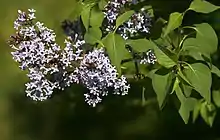Syringa komarowii
Syringa komarowii is a species of lilac native to central China, commonly called nodding lilac. It is native to the Provinces of Gansu, Hubei, Shaanxi, Sichuan, Yunnan.[2]
| Nodding lilac | |
|---|---|
 | |
| Syringa komarowii subsp. reflexa | |
| Scientific classification | |
| Kingdom: | Plantae |
| Clade: | Tracheophytes |
| Clade: | Angiosperms |
| Clade: | Eudicots |
| Clade: | Asterids |
| Order: | Lamiales |
| Family: | Oleaceae |
| Genus: | Syringa |
| Species: | S. komarowii |
| Binomial name | |
| Syringa komarowii | |
| Synonyms[1] | |
| |
It is a shrub growing to 3–6 m tall, with erect branches. The leaves are oval-oblong, 5–19 cm long and 2–7 cm broad. The flowers are fragrant and range in colour from pink to mauve, sometimes with a white base; they are produced in early summer on panicles 4–25 cm long and are attractive to bees, butterflies, and birds. The panicles often hang limply, which is how the plant got its common name; the clusters look as though they are nodding.[2][3][4]
There are two subspecies:
- Syringa komarowii subsp. komarowii C.K.Schneid.
- Syringa komarowii subsp. reflexa (C.K.Schneid.) P.S.Green & M.C.Chang.
Cultivation and uses
Like most lilacs, it needs to be planted in full sun. It is able to survive cold winters. The flowers are good for cutting. While this plant is beautiful, it is not commonly used in landscaping. However, it is used for breeding with other species of Syringa.
References
- "The Plant List: A Working List of All Plant Species".
- Flora of China: Syringa komarowii
- "Syringa komarowii". Germplasm Resources Information Network. Agricultural Research Service, United States Department of Agriculture. Retrieved 29 January 2018.
- Schneider, Camillo Karl. 1910. Repertorium Specierum Novarum Regni Vegetabilis 9: 82